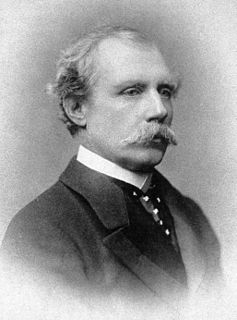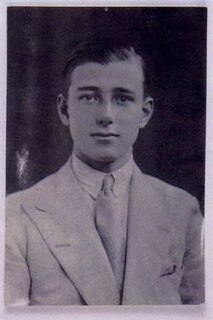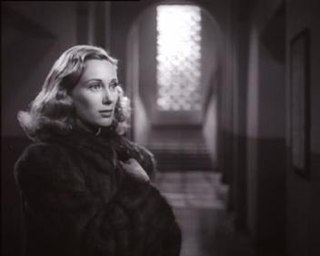See also
- Vyners School, a secondary school and specialist college in the London Borough of Hillingdon
Vyner is a surname.
Vyner may also refer to:

Kuching, officially the City of Kuching, is the capital and the most populous city in the state of Sarawak in Malaysia. It is also the capital of Kuching Division. The city is on the Sarawak River at the southwest tip of the state of Sarawak on the island of Borneo and covers an area of 431 square kilometres (166 sq mi) with a population about 165,642 in the Kuching North administrative region and 159,490 in the Kuching South administrative region—a total of 325,132 people.

Charles Brooke, Rajah of Sarawak, GCMG, born Charles Anthoni Johnson, ruled as the head of state of Raj of Sarawak from 3 August 1868 until his death. He succeeded his uncle, James Brooke, as the second White Rajah of this small country on the coast of Borneo.

Vyner, Rajah of Sarawak, GCMG, full name Charles Vyner de Windt Brooke, was the third and last White Rajah of the Raj of Sarawak.

The White Rajahs were a dynastic monarchy of the British Brooke family, who founded and ruled the Raj of Sarawak, located on the north west coast of the island of Borneo, from 1841 to 1946. The first ruler was Briton James Brooke. As a reward for helping the Sultanate of Brunei fight piracy and insurgency among the indigenous peoples, he was granted the province of Kuching, which was known as Sarawak Asal in 1841 and received independent kingdom status.

Cambridge Heath is an urban area of Bethnal Green in the London Borough of Tower Hamlets, approximately 5.7 km (3.5 mi) north east of Charing Cross. It is named after a former heath in the East End of London. The northern boundary is formed by the Regent's Canal and the area includes Vyner Street, best known for its street art and galleries.

Tun Datuk Abang Haji Openg bin Abang Sapiee was a Malaysian politician who served as the first Yang di-Pertua Negeri of Sarawak from September 1963 to his death in March 1969. He assumed the newly established post following Sarawak's independence from the Great Britain and the formation of Malaysia in 1963.
SS Vyner Brooke was a Scottish-built steamship that was both the royal yacht of Sarawak and a merchant ship frequently used between Singapore and Kuching. She was named after the 3rd Rajah of Sarawak, Sir Charles Vyner Brooke. At the outbreak of war with Japan the ship was requisitioned by the Royal Navy, armed, and sunk in 1942.

The Raj of Sarawak, also State of Sarawak, located in the northwestern part of the island of Borneo, was an independent state that later became a British Protectorate. It was established as an independent state from a series of land concessions acquired by an Englishman, James Brooke, from the Sultan of Brunei. Sarawak received recognition as an independent state from the United States in 1850, and from the United Kingdom in 1864.

Anthony Walter Dayrell Brooke was appointed the Rajah Muda of Sarawak on 25 August 1937, by his uncle, Rajah Vyner of Sarawak the third and last of the ruling White Rajahs.
Charles Brooke may refer to:
John Coney Moulton (1886–1926) was born in St Leonards-on-Sea, Sussex, England, and died in London. He was an officer in the British Army, as well as an amateur zoologist who spent many years in South-East Asia.

Sylvia Leonora, Lady Brooke, Ranee of Sarawak, was an English aristocrat who became the consort to Sir Charles Vyner de Windt Brooke, Rajah of Sarawak, the last of the White Rajahs.
Vyners School is a secondary school and sixth form in Ickenham within the London Borough of Hillingdon. Since November 2011 the school has had an academy status.

History of Sarawak can be traced as far as 40,000 years ago to the paleolithic period where the earliest evidence of human settlement is found in the Niah caves. A series of Chinese ceramics dated from the 8th to 13th century AD was uncovered at the archeological site of Santubong. The coastal regions of Sarawak came under the influence of the Bruneian Empire in the 16th century. In 1839, James Brooke, a British explorer, first arrived in Sarawak. Sarawak was later governed by the Brooke family between 1841 and 1946. During World War II, it was occupied by the Japanese for three years. After the war, the last White Rajah, Charles Vyner Brooke, ceded Sarawak to Britain, and in 1946 it became a British Crown Colony. On 22 July 1963, Sarawak was granted self-government by the British. Following this, it became one of the founding members of the Federation of Malaysia, established on 16 September 1963. However, the federation was opposed by Indonesia, and this led to the three-year Indonesia–Malaysia confrontation. From 1960 to 1990, Sarawak experienced a communist insurgency.
Kenelm Hubert Digby MBE was the proposer of the controversial 1933 "King and Country" debate in the Oxford Union who later became the Attorney General and a judge in Sarawak.

Margaret Leila Vyner was an Australian-born model and actress who appeared in British films. She collaborated with husband Hugh Williams on a number of successful theatre projects in the 1950s and 1960s.

The anti-cession movement of Sarawak was a movement in Sarawak to fight against the British attempt to govern Sarawak as a crown colony rather than a protectorate ruled by the White Rajahs. The movement lasted from 1 July 1946 until March 1950.

The Crown Colony of Sarawak was a British Crown colony on the island of Borneo, established in 1946, shortly after the dissolution of the British Military Administration. It was succeeded as the state of Sarawak through the formation of the Federation of Malaysia on 16 September 1963.

Vyner Street is a cobblestone canal-side walkway in Bethnal Green in the East End of London, England. It was once called John Street in the 1830s. The street is known for its street art and for its galleries.

An equestrian statue of Charles II trampling Cromwell stands near Newby Hall in North Yorkshire, England. It was previously sited at Gautby Hall in Lincolnshire, and was originally installed at the Stocks Market in the City of London. It is a Grade II listed building.